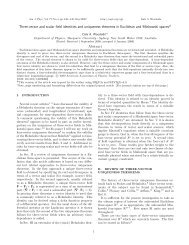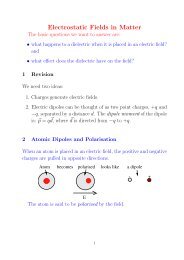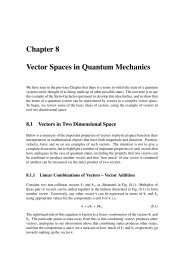<strong>AOS</strong> <strong>News</strong> Volume 25 Number 1 2011Chiral MetamaterialsUnlocking Nonlinear <strong>Optical</strong> ActivityWe demonstrate a chiral metamaterial exhibiting nonlinear optical activity –polarisation rotation which depends on the magnitude of the incidentfield. This effect is almost negligible in natural materials, but can bemade very strong using artificially structured metamaterials. We utilise this effectto create an optical diode for circularly polarised waves – a device which allowstransmission only in one direction.Chirality has important implications inmany areas of physics and chemistry,including optics. A chiral structure isone which has distinct left and righthandedforms which are the mirrorimages of each other. It is known thatthe interaction of circularly polarisedlight with chiral molecules depend onthe relative handedness between thetwo. This is the basis of the well-knownoptical activity in sugar solutions, wherebya linearly polarised input wave has itspolarisation rotated at the output. <strong>The</strong>microscopic origin of this effect is theexcitation of a magnetic response by theelectric component of the light and viceversa. Although the effect exists in naturalmedia, it can be orders of magnitudestronger in artificially structured media- metamaterials. In place of molecules,one can engineer tiny, sub-wavelengthelements such as resonant spirals thatact as magneto-electric dipoles. Figure 1shows an example of a chiral metamaterial,showing a linearly polarised incidentplane wave, which undergoes polarisationrotation by angle θ.<strong>The</strong> polarisation rotation in microwavechiral metamaterials can be nearly amillion times stronger than in naturalquartz for optical frequencies, oncethe sample thickness is normalised tothe wavelength of radiation [1]. Forsuch chiral metamaterials, the effect ofoptical activity can be so strong thatthe refractive index becomes negativefor one circular polarisation. <strong>The</strong>re aremany other examples in the literatureof how metamaterials can be engineeredto achieve linear material parameters farbeyond those of natural media. An evenmore exciting feature of metamaterialsis that they can achieve exotic nonlinearparameters. Previous results have shownthat a nonlinear inclusion in an opticalor microwave metamaterial can resultin a nonlinear response much strongerthan that in the corresponding bulknonlinear media [2]. This occurs due tothe resonant enhancement of fields, andthe local hot spots which develop withinthe structure.by David A. Powell, Ilya V. Shadrivov, Vassili A.Fedotov, Nikolay I. Zheludev and Yuri S. KivsharNonlinear Chiral MetamaterialOur aim is to combine the strongchirality and nonlinearity of metamaterialsto develop a structure with nonlinearoptical activity - polarisation rotationwhich depends on the strength of theincident field. This effect has previouslybeen proposed [3], and subsequentlyobserved in LiIO3 crystals [4], however insuch materials the nonlinear optical activitywas smaller than its linear counterpart bya factor of 10-6. This required samplesseveral centimetres in length and lightintensities of 100 MW/cm2, which isclose to the optical breakdown of thecrystal. Such a small level of nonlinearityis not sufficient for demonstrating anypractically important functionality.Using metamaterials, we can overcomethese difficulties, by engineering thechiral response and carefully placing thenonlinear elements within the structure.<strong>The</strong> metamaterial is designed to operateat microwave frequencies, and consistsof a pair of metallic wires, twisted so thatthey are no longer parallel, as shown inFigure 2. We can see that the structure ischiral, because if we take its mirror image,we end up with a non-identical object.Nonlinearity is introduced by cuttingeach wire and inserting a varactor diode.<strong>The</strong> structure is placed inside a circularwaveguide, and excited with a high powermicrowave source in the 5-7GHz range.Figure 1. Example chiral metamaterial showing polarisationrotation.Figure 2. Schematic of the nonlinear chiral metamaterial.28
<strong>AOS</strong> <strong>News</strong> Volume 25 Number 1 2011Figure 3. Polarisation rotation as a function ofinput frequency and power.Further details of the design and theexperimental techniques can be foundin [2].We note that the angle of twist isan important parameter, which notonly determines the magnitude of thegyrotropy [1], but also changes theresonant frequency of the metamoleculedue to strong near-field interactions [5].In general chiral and anisotropic structureshave elliptically polarised eigenmodes,leading to a complex dependence of thepolarisation state of the transmitted waveon the incident polarisation state. Weobserved no change of our results whenthe metamolecule was rotated along itsaxis in the cylindrical waveguide. Thisindicates that anisotropic, birefringenceeffects are negligible and the polarisationchange is dominated by the circulardichroism and circular birefringence ofthe sample. This allows us to describe thetransmission in terms of the transmissionof the left- and right-handed circularlypolarised waves, T-- and T++.Figure 3 show polarisation rotationof a linearly polarised wave for differentincident intensities. <strong>The</strong> resonant featurecomes from the resonant excitation ofFigure 4. Difference between forward andbackward transmission for the optical diode.currents in the left-handed metamoleculeby the left-handed circularly polarisedwave. Our numerical simulations confirmthat the excited resonance corresponds toout-of-phase currents in the wires. At thesame time, the right-handed circularlypolarised wave does not noticeably exciteany resonances in our structure. Changingthe power of the incident wave shifts theresonance of the gyrotropic response to ahigher frequency. Importantly, such a shiftof the polarisation rotation resonance leadsto giant nonlinear gyrotropy. This can becalculated as achieving a peak value of 15deg°/W, which is 12 orders of magnitudestronger than results previously observedfor LiIO3, at optical wavelengths [4].<strong>Optical</strong> Diode for CircularlyPolarised WavesIf we modify the structure suchthat only one wire contains a nonlinearinclusion, then it will have a lowersymmetry, and we can use this featurein order to allow the propagation ofleft-handed circularly polarised wavesin one direction only. This relies on thenon-reciprocity of nonlinear components,which becomes significant at higher inputpowers. <strong>The</strong> results of our measurementsfor the left-handed circularly polarisedwave scattering on a left-handed chiralmetamolecule are shown in Figure 4.When the amplitude of the incidentwave is small, the structure shows alinear response, and the transmissioncoefficients in both directions are equal.However, in the nonlinear regime, withhigh intensity of the impinging wave weobserve considerably different transmissionproperties in opposite directions with themaximal intensity contrast between thetwo directions of 18 dB. Our numericalmodelling shows that such behaviourresults from significantly different currentamplitudes induced in the two wire stripsby the waves entering the metamoleculefrom one direction, in comparisons witha much smaller excitation differenceproduced by a wave entering from theopposite direction. <strong>The</strong> ‘polarity’ of themetamaterial diode depends on theoperating frequency: In the range 5.9 - 6.0GHz the transmission for the left-handedcircularly polarised wave is greater in theforward direction, i.e. when the wave hitsthe strip with the nonlinear element first.However, in the range from 6.0 GHz to6.3 GHz the ‘polarity’ reverses and thediode transmits the same polarisation inthe opposite direction only.ConclusionWe have demonstrated a metamaterialshowing significant nonlinear opticalactivity, an effect which is extremely weakin natural materials. We then modified thisstructure to create an asymmetric version,which acts as an optical diode for circularlypolarised waves, allowing transmission ofthe left-handed circular polarisation onlyin one direction.AcknowledgementsThis work was supported by the<strong>Australian</strong> Research Council, by the<strong>Australian</strong> Academy of Science TravelGrant, and by the Engineering andPhysical Sciences Research Council UKand <strong>The</strong> Royal <strong>Society</strong> (London).References[1] A.V. Rogacheva, V.A. Fedotov, A.S.Schwanecke, and N.I. Zheludev, “GiantGyrotropy due to Electromagnetic-Field Coupling in a Bilayered ChiralStructure,” Physical Review Letters,vol. 97, Oct. 2006, pp. 1-4.[2] I.V. Shadrivov, V.A. Fedotov, D.A.Powell, Y.S. Kivshar, and N.I.Zheludev, “Electromagnetic waveanalogue of an electronic diode,” NewJournal of Physics, vol. 13, Mar. 2011,p. 033025.[3] S.A. Akhmanov and V.I. Zharikov,“Nonlinear optics of gyrotropicmedia,” JETP Lett., vol. 6, 1967, pp.137-140.[4] S.A. Akhmanov, B.V. Zdanov, N.I.Zheludev, N.I. Kovrigin, and V.I.Kuznetsov, “Nonlinear optical activityin crystals,” JETP Lett., vol. 29, 1979,pp. 264-268.[5] M. Lapine, D.A. Powell, M.V.Gorkunov, I.V. Shadrivov, R. Marqués,and Y.S. Kivshar, “Structural tunabilityin metamaterials,” Applied PhysicsLetters, vol. 95, 2009, p. 084105.David A. Powell, Ilya V. Shadrivov and YuriS. Kivshar are with the Nonlinear PhysicsCentre and CUDOS@ANU, ResearchSchool of Physics and Engineering, ANU,Canberra. Vassili A. Fedotov and NikolayI. Zheludev are with the OptoelectronicsResearch Centre and Centre for PhotonicMetamaterials, <strong>University</strong> of Southampton,United Kingdom.29
















